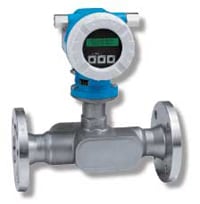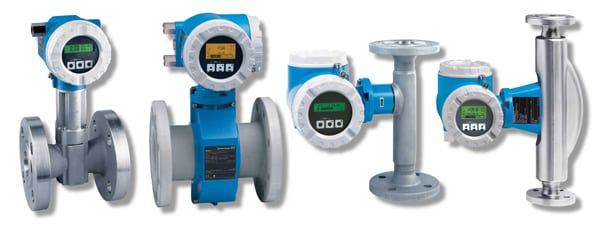The whole-product-lifecycle approach for flowmeters presented here encompasses more than basic selection
Typical discussions of flowmeter selection address specifications, technologies, accuracies and performance, but there are many other steps that are not normally considered. This article focuses on these often overlooked criteria, which inevitably have far-reaching and costly implications over the life of the flow-measurement instrument chosen.
 |
| Figure 1. Choosing the best flowmeter for the application is important, but it is only the first step in proper selection |
In the current economic environment, every aspect of a flowmeter that impacts an organization’s bottom line must be given consideration, even if it does not appear to affect the original purchase price. There are several less-than-obvious issues to review with any supplier you are doing business with that have cost-saving implications. Failing to pay attention to these factors early in the discussion could lead to greater costs in the long run. It pays to take the time up front to ensure you have made the proper selection.
The selection process proposed here involves a whole-product-lifecycle approach to flowmeters that takes into account several steps from engineering through many years of operation. This article takes a “business-minded” approach, in that the full economic impact of the instrument’s life is considered.
Each step of the instrumentation-selection process can be supported with modern tools that are designed to improve processes and lower the total cost of ownership. This is real game-changing technology that many users are not aware of, as such tools are outside the obvious realm of the flowmeter itself. The selection process is not as much about picking a certain type of meter for a given application based on how that certain flowmeter works, as it is about a bigger picture. Considering all aspects of this full approach has a significant longterm impact on operational efficiency and related budgets.
Proper flow technology selection
While choosing the proper flow instrument for an application is a very important step, it is also shortsighted to believe that the selection process is done when the instrument is chosen (Figure 1). Rather than discussing this topic in detail, it can simply be said that the best recommendation is to utilize one of the several existing programs now available to help eliminate much of the guesswork (For more on flow technology, see Evaluating Industrial Flowmeters, CE, April 2007, pp. 54 – 59).
New technology. Software tools for instrumentation selection can either run on a computer desktop or be accessed via the Web. These recently perfected tools take advantage of the experience gained over many years of successful implementation of different measurement techniques. It is best to employ a tool that takes a vast array of available instrumentation into account to ensure that as many options as possible are considered and compared. In addition, the latest Web-application interface developments enable these tools to integrate directly with existing computer-aided engineering (CAE) and design engineering packages to improve the documentation and recordkeeping involved in the design phase of an entire process facility. The quality of information and the improved efficiency of this process can have a dramatic impact on the completion cycle while reducing associated errors.
Cost implication. Most of these tools are available from a number of sources for use at no charge, so there is little risk in giving one a try. The impact of selecting the wrong technology can be costly, due not only to the money wasted on the improper meter, but the re-engineering, lost production, and rework from removal and replacement that could have been avoided with proper selection.
 |
| Figure 2. New procurement tools allow integration with a supplier’s order-entry system, or even live access to the manufacturer’s configuration system. These tools allow users to view a complete comparison of flowmeter types and sizes, offering a full array of available models and options. From left to right, vortex, electromagnetic, thermal mass and Coriolis flowmeters are shown |
Sizing tools
Beyond selecting the correct technology, it is also critical that a correctly sized meter is installed in order to get the most from an investment. The best measurement technology cannot overcome poor installation. A high percentage of early troubleshooting problems is the result of issues that were not taken into account before the purchase. Discovering a problem after it is too late compounds the problem and may result in the need for a complete replacement, which may have been prevented if care had been taken at the beginning. Calculations involving pump rates, flow velocities, pipe sizes, pressure drops, bends, obstructions and so on, can get very involved and time consuming, but help is available.
New technology. Accurate calculations and outcome predictions involving all aspects of an installation can be performed using tools that determine performance based on inputted conditions. Many different “what-if” scenarios can be executed to see how they impact results, and these models can even be used to help make piping design decisions very early in the process development.
Cost implication. By performing a sufficient amount of analysis and installing the correct size instrument from the beginning, the time wasted later reviewing the application and implementing fixes can be eliminated. Fewer surprises will occur if time is invested initially using readily available tools designed to correctly size meters. On the other hand, if fixes are not made and an improperly sized meter is left in the process, quality and performance will suffer, adding up to losses over the life of the device.
Procurement tools
Because standard purchasing processes have been based on manual paperwork in the past, the procurement step is often overlooked. In the last ten years, however, there have been major advancements in procurement systems, including emerging methods that cut down the hours required to place orders. This has been driven by the need to reduce internal costs for purchasing, cut down on the amount of paper generated, and collaborate with innovative vendors that have the e-business capabilities to help buyers realize areas for cost reductions.
New technology. Advanced platforms now extend what was once only available on a powerful enterprise resource planning (ERP) system to a local CD-ROM tool. Such platforms can integrate fully with a supplier’s order-entry system. In some cases, live access via secure account login to the manufacturer’s actual configuration system can be used to build a complete model structure (Figure 2). With a user account, once the flowmeter selection and sizing have been completed, the net prices can even be seen immediately, and various models or options can be compared. A group of suppliers have been working with standards committees to make ISA Specification Sheets, and NE100 (ProList) documents available with product attributes in.xml format to streamline the process of generating bid requests on major projects. This is not just online shopping; it is an integrated process for simplifying the entire purchasing cycle, eliminating errors, and taking advantage of multi-million dollar e-Procurement investments already made by many purchasing departments.
Cost implication. Time is money, and in this case, the money savings can be significant, considering the hours consumed in requesting quotes from vendors, gathering bids, accurately documenting the devices being considered, comparing various choices and conveying all of this to buyers in order to generate the purchase orders.
Calibration in accredited labs
Since a flowmeter is purchased simply to provide accurate measurement data, how good is that investment if the measurement accuracy is questionable? A device should have its calibration performed on a production flow rig that is accredited by a third-party agency (the American Association of Laboratory Accreditation) and certified to be NIST traceable.
New technology. The ISO 17025 standard allows manufacturers to received accreditation based on strict calibration procedures, using equipment of the highest performance. The results are factory capabilities that achieve repeatable calibrations with uncertainties that were not achievable even just a few years ago. These high-precision calibration rigs provide premium calibrations that exceed what was previously only available from national laboratories.
Cost implication. With these new levels of premium calibration now available from some flowmeter manufacturers, the precision of an instrument can be held to such tight ranges that the production processes can be further improved to even greater productivity. To the end user, this means tighter control, less waste and improved product quality, which all translate directly to the bottom line.
Proper installation and startup
Even if the first four steps discussed thus far are followed carefully, it is all for nothing if the instrument is installed poorly. With today’s sophisticated electronic transmitters, this goes well beyond the mechanical mounting in the pipe. Several critical parameters in the device programming must be set up properly to achieve the greatest measurement results. Users demand more capabilities and greater performance from their flowmeters, and while this is achievable, it causes the instrument design to become more complex. Therefore, greater care must be taken in performing the initial programming to achieve the desired performance.
New technology. New tools are now offered in addition to basic meters that maximize the performance of those meters. Dedicated applications for installation on personal digital assistants (PDAs) are powerful tools for getting the most out of devices. The most recent of these handhelds are ruggedized for industrial environments and are even approved for explosion hazard areas. They utilize WiFi interfaces so that instrument enclosures are not compromised. Software applications are developed specifically for the devices being programmed, where parameters are unique to the make and model so that all values entered enable peak performance. With immediate feedback on operational performance, the instrument can essentially be tuned to the process in which it is installed. These same handhelds can be used again later when troubleshooting any problems encountered over the life of the instrument.
Cost implication. Having a single handheld device to communicate with multiple instruments (including but not limited to flowmeters) is very cost efficient, as only one programmer needs to be bought, supported and learned by technicians. Many instrumentation companies have joined forces to standardize on the newest Field Device Tool (FDT) platform so that users can take advantage of this concept. Suppliers offer unique DTMs (Device Type Managers) for each model, which enables users to get the most out of the device. Since new applications can be installed in the future, it provides a great return on the investment.
Maintenance, repair & operations
The maintenance, repair and operations (MRO) phase naturally comes well after the purchase is made. Selecting a meter with some limited features will often also limit the ability to implement some of these great performance capabilities. It pays to understand from the beginning how well the product is designed to take advantage of these powerful tools.
New technology. There is a host of available tools that will increase staff productivity and extend the life of installed meters. Some can be installed locally, and others are online, but just to be in a position to use some of these can be determined well before the flowmeter is selected and ordered. A brief list is shown with the associated benefits in Table 1 to provide a sample of the great offerings that exist, many of which were not available even just a few years ago. Though few companies would use every single one of these tools, employing several is the norm.
| Tool | Benefit |
|---|---|
| Web-enabled asset management portal | 24/7 immediate access to important asset information |
| Computerized calibration management software | Tools to transfer on-board meter data to PC package |
| Parts lists and drawings database | Ready access for users to speed maintenance |
| Repair concepts | Quick swap-out of boards, modules, program data chips |
| Product status list | Quickly determines age, and parts and repair availability |
| Order code translator | Helps to quickly determine replacements for obsolete meters |
| Predictive maintenance | Avoid unexpected downtime |
| Condition monitoring | Realtime reporting on meter health to signal problems |
| Meter data Integration with existing CMMS packages (for example, Maximo, Datastream and so on) | Maximize investment already made with minimal effort |
| Ethernet & wireless communications | Transfer information into plant asset management system |
| Digital communications (for example, Foundation Fieldbus, HART and so on) | Protocols compatible with existing network |
| Web applications and data hosting for site monitoring and inventory control | Supply chain management benefits |
Local service centers with A2LA accreditation provide quick turnaround and perform onsite flow calibrations with mobile, traceable rigs that meet ISO 17025 standards. This includes the required record keeping and certificates documented to meet the quality standards of a company’s maintenance-management procedures. If a meter is selected that cannot work with any of these calibration rigs, the benefits can never be realized, so it is best to be aware of their compatibility ahead of time.
Cost implication. It cannot be overemphasized that a chosen flowmeter may or may not have the design features needed to enable the implementation of MRO tools. The operational phase can incur up to ten times or more the initial purchase cost of the meter. Therefore, it makes sense to consider any of these capabilities that would be important to the operation over the life of the instrument before deciding which unit to install. Otherwise, the full cost savings benefit that many of these new tools offer cannot be achieved. Employing one or several of these tools can have an impact on the operation of the process over the life of the flowmeter in terms of manpower, efficiency and overall productivity.
Training and technical support
All of the newest technology and product design improvements offer users unprecedented performance, but to take advantage of this technology, full understanding and the ability to implement it are required. Never before has training been more important, so selecting the right flowmeter also means selecting the organization that will help the user get the most from the purchase.
New technology. New methods of learning and education are now employed in the process control industry. Not only are traditional classroom courses still being conducted, and in more convenient locations with hands-on sessions, but online sessions in the form of live Webinars and eLearning portals with recorded training modules are also being offered. This allows users to easily receive necessary training without having to leave the office or take time away from normal work hours.
Beyond learning sessions, when emergencies arise and answers are much more time critical, a team of factory-trained technicians, either onsite or by phone support, are extremely important. The latest phone systems and customer-support software enable vendors to offer higher quality support that exceeds what was previously possible. These support systems engage the user with tools that accelerate the problem-resolution process and help owners get the most from their instrumentation.
Cost implication. Learning at a flexible pace and schedule allows users to obtain training information easily. With no travel expenses or time away from work, employers can allow workers to improve their skills at minimal expense. Working with a supplier that makes use of efficient communication methods helps users get the immediate answers needed to help keep operational costs down.
In emergency situations, a quick response team is invaluable. By getting answers needed in a timely manner, downtime is minimized, production upsets are reduced and output (and thus revenue) is maximized. The result is that, ultimately, the flowmeter selected has provided its greatest possible value — a high return on its investment.
This multi-step process should be of interest not only to engineers, but also to purchasing groups, maintenance technicians, operators, quality departments, plant managers and even the associated financial group. Such groups may have influence on flowmeter selection that involve a number of nontraditional elements that buyers may overlook. With this in mind, it is recommended to use a team approach to ensure that the vendor selected will meet the expectations of the entire organization.
Economics and operational performance issues are hot topics today given the current business condition, leading users to look for ways to cut costs. The critical information discussed here, upon which to base flowmeter selection, is highly valuable. Considering all of these factors will, over time, prove that selection should not be based only on the initial price but on every related aspect of spending that stems from the operation of that flowmeter. By going beyond the first couple of steps normally taken and considering additional aspects of price versus performance, significant economic savings can be achieved in the long run.
Edited by Kate Torzewski
Author
|
 Jerry R. Spindler is a product marketing group manager with Endress+Hauser, Inc. (2350 Endress Place, Greenwood, IN 46143; Phone: 888-363-7377; Fax: 317-535-2233; Email:
Jerry R. Spindler is a product marketing group manager with Endress+Hauser, Inc. (2350 Endress Place, Greenwood, IN 46143; Phone: 888-363-7377; Fax: 317-535-2233; Email: